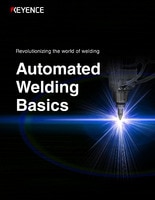Types of electron beam welding
Electron beam welding machines are categorized according to the accelerating voltage, the processing chamber pressure, and the electron gun mounting position. These differences affect the scale and manageability of the equipment as well as the welding processes that can be performed.
- Accelerating voltage (high voltage vs. low voltage)
- Processing chamber pressure (high vacuum vs. low vacuum)
- Electron gun mounting position (fixed electron gun vs. moving electron gun)
Accelerating voltage (high voltage vs. low voltage)
The accelerating voltage significantly influences the output of the electron beam. In general, devices with an accelerating voltage of about 100 to 150 kV are considered high voltage, and devices of about 30 to 60 kV are considered low voltage.
High-voltage devices can weld steel materials between about 0.1 and 200 mm thick, and aluminum alloys between about 0.1 to 300 mm thick.
For non-specialized applications, low-voltage devices are easier to use. Such devices are used in various fields, including the electronic component industry.
Processing chamber pressure (high vacuum vs. low vacuum)
One of the major characteristics of electron beam welders is that welding is performed in a vacuum processing chamber. In recent years, however, electron beam welding machines capable of welding even without a perfect vacuum have been developed.
In general, processing chambers with pressures up to about 0.067 Pa are considered high-vacuum chambers, and those with pressures up to about 6.67 Pa are considered low-vacuum chambers. Processing chamber pressures vary from approximately 6.67 Pa to 1.3×10-6 Pa depending on the application, and the volumes are increasing with some equipment boasting an internal volume of several hundred cubic meters.
General-purpose high-vacuum exhaust devices include the following:
- Oil diffusion pumps
- Mechanical booster pumps
- Oil rotary pumps
Low-vacuum devices, on the other hand, include the following:
- Mechanical booster pumps
- Oil rotary pumps
Recently, devices equipped with scroll pumps and turbomolecular pumps offering less noise, vibration, and heat are being developed thanks to improvements to the installation environment and energy efficiency.
Electron gun mounting position (fixed electron gun vs. moving electron gun)
The electron gun used to emit the electron beam can be mounted either inside or outside the processing chamber
External devices, with the electron gun mounted outside the processing chamber, are generally categorized as fixed or movable with a special sliding seal. With fixed electron gun devices, the welding position is changed by moving the base material.
With moving electron gun devices, on the other hand, the welding position is changed by moving the electron gun. Moving electron gun devices can have a moving stroke of several meters, enabling welding at a wide variety of positions.
Internal devices, with a moving electron gun mounted inside the processing chamber, feature an electron gun attached to a robot capable of simultaneous control along five axes (X, Y, Z, A, and C). These devices are capable of three-dimensional welding, and some devices offer a welding area of 10 m or more. 3D weld position scanning is performed by a low-power beam positioned transversely to the weld line. X-rays generated during welding are detected by a sensor built into the electron gun, ensuring accurate welding for grooves.





